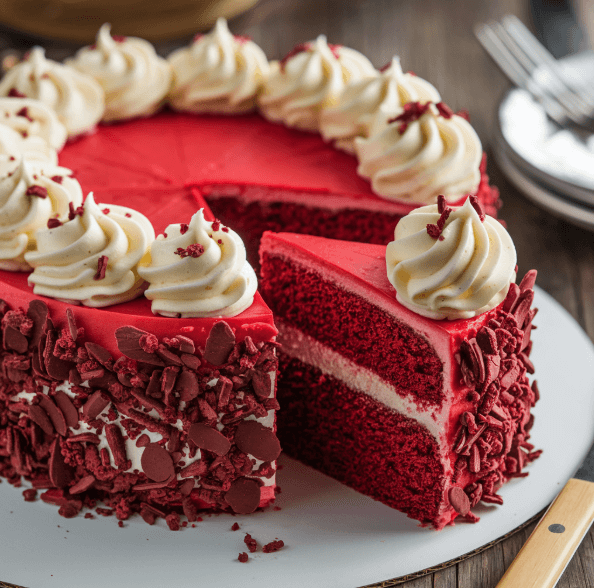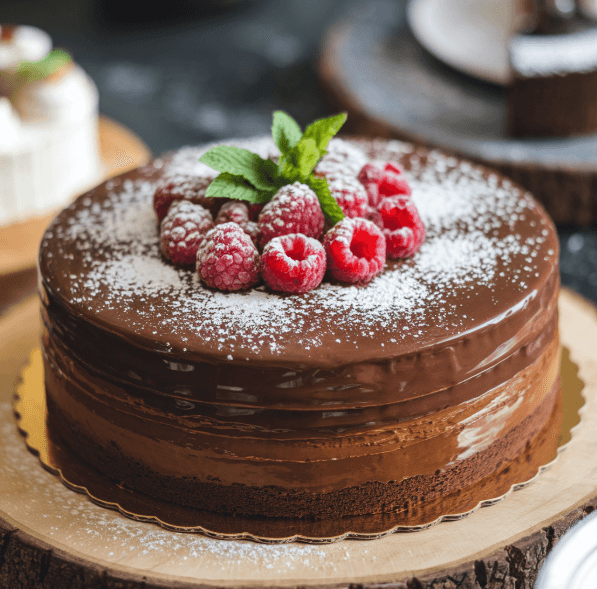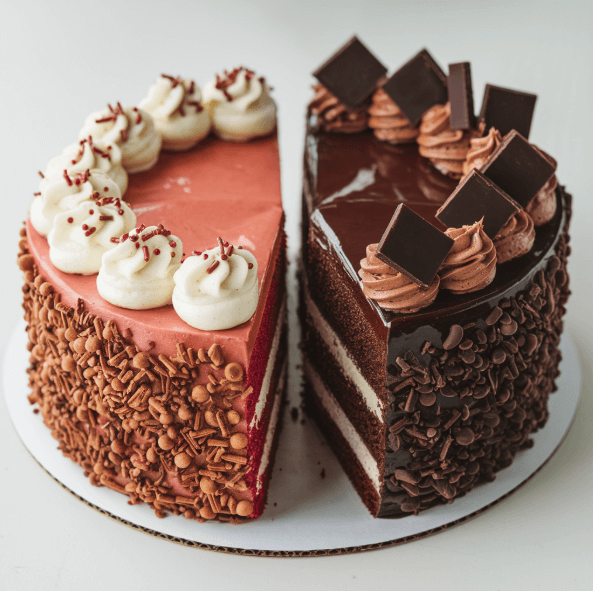Introduction
When it comes to desserts, few debates are as deliciously divisive as red velvet cake vs chocolate cake. At first glance, they might seem similar after all, both are moist, decadent, and often topped with luscious frosting. But dig a little deeper, and you’ll discover that these two cakes are worlds apart. From their unique ingredients to their distinct flavors and textures, what makes red velvet cake different from chocolate cake is a fascinating tale of culinary science, history, and artistry.
In this article, we’ll explore the key differences between these iconic desserts, uncover their origins, and even dive into their nutritional profiles. Whether you’re a baking enthusiast or simply a dessert lover, you’ll walk away with a deeper appreciation for both cakes and maybe even a craving to bake one yourself!
1. The History and Origin of Both Cakes
The History of Red Velvet Cake
The story of red velvet cake is as rich and layered as the dessert itself. While its exact origins are a bit murky, many believe it first gained popularity during the Victorian era, where its striking red hue and velvety texture made it a standout at high-society gatherings. However, it wasn’t until the 20th century that the cake truly became a sensation, thanks in part to the Adams Extract Company.
During the Great Depression, the company cleverly promoted its red food coloring by sharing red velvet cake recipes, which quickly became a hit in the Southern United States. But what really sets this cake apart is its unique combination of ingredients buttermilk, vinegar, and a touch of cocoa powder. These elements create a chemical reaction that gives the cake its signature tangy flavor and soft, velvety crumb.
Interestingly, the cake’s vibrant red color wasn’t always achieved with food coloring. In the past, bakers relied on natural ingredients like beetroot to enhance the hue. Today, though, most recipes call for a dash of red food coloring to achieve that iconic look.
The History of Chocolate Cake
On the other hand, chocolate cake has a history that’s equally captivating but decidedly different. Its roots can be traced back to the 18th century, when chocolate was first introduced to Europe. Initially, chocolate was consumed as a beverage, but as cocoa powder became more widely available, bakers began experimenting with it in cakes.
The invention of Dutch-processed cocoa powder in the 19th century was a game-changer. This type of cocoa, which is treated with an alkali to neutralize its acidity, gave chocolate cakes a richer, deeper flavor. By the early 20th century, chocolate cake had become a staple in households worldwide, with countless variations emerging over the years.
From flourless chocolate cakes to molten lava cakes, this dessert has evolved into a versatile treat that can be enjoyed in countless ways. Its rich, indulgent flavor and dense texture have made it a favorite for celebrations and everyday indulgences alike.
2. Key Differences Between Red Velvet Cake and Chocolate Cake
2.1 Ingredients : What Sets Them Apart?
When it comes to what makes red velvet cake different from chocolate cake, the ingredients are where the magic begins. At first glance, both cakes might seem similar—they both contain flour, sugar, eggs, and some form of chocolate. But dig a little deeper, and you’ll find that the devil is in the details.
Red Velvet Cake Ingredients
The red velvet cake is a masterclass in balance. It uses a small amount of cocoa powder just enough to hint at chocolate without overpowering the other flavors. The real stars of the show are buttermilk and vinegar, which work together to create a chemical reaction that gives the cake its signature tangy flavor and soft, velvety texture.
But let’s not forget the red food coloring the ingredient that gives this cake its iconic hue. While some recipes use natural alternatives like beetroot, most modern versions rely on food coloring to achieve that vibrant red. Finally, cream cheese frosting is the crowning glory, adding a creamy, slightly tangy contrast to the cake’s subtle sweetness.
Chocolate Cake Ingredients
In contrast, chocolate cake is all about the chocolate. It typically uses a much larger amount of cocoa powder or even melted chocolate, giving it a deep, intense flavor. Unlike red velvet cake, there’s no buttermilk or vinegar here instead, the recipe relies on ingredients like baking soda or baking powder to achieve the perfect rise.
The frosting options for chocolate cake are equally indulgent. From chocolate ganache to buttercream, the goal is to double down on the chocolatey goodness. While some variations might include a hint of coffee to enhance the chocolate flavor, the focus is always on creating a rich, decadent dessert.
2.2 Flavor Profile: A Taste Comparison
If you’ve ever wondered why red velvet cake and chocolate cake taste so different, the answer lies in their unique flavor profiles.

The Unique Flavor of Red Velvet Cake
Red velvet cake is all about subtlety. The small amount of cocoa powder gives it a mild chocolate flavor, while the buttermilk and vinegar add a tangy, slightly acidic note. This combination creates a complex flavor that’s both sweet and slightly savory.
The cream cheese frosting plays a crucial role here, too. Its creamy, tangy flavor complements the cake perfectly, creating a harmonious balance that’s hard to resist. It’s no wonder this cake has become a favorite for weddings and special occasions!
The Rich Flavor of Chocolate Cake
On the other hand, chocolate cake is a chocolate lover’s dream. With its higher cocoa content, this cake delivers a bold, intense chocolate flavor that’s impossible to ignore. Whether it’s a classic dark chocolate cake or a sweeter milk chocolate version, the goal is to create a dessert that’s rich, indulgent, and utterly satisfying.
The frosting options only add to the decadence. A layer of chocolate ganache or buttercream takes the flavor to the next level, making this cake a go-to choice for birthdays, holidays, and any occasion that calls for a little indulgence.
2.3 Texture: How Do They Feel on the Palate?
When it comes to texture, red velvet cake and chocolate cake couldn’t be more different.
The Velvety Texture of Red Velvet Cake
True to its name, red velvet cake has a soft, fine crumb that practically melts in your mouth. This is thanks to the combination of buttermilk and vinegar, which work together to create a tender, moist texture. The result is a cake that’s light and airy, yet still rich enough to feel indulgent.
The Dense and Rich Texture of Chocolate Cake
In contrast, chocolate cake tends to be denser and heavier. The higher cocoa content and lack of buttermilk give it a more substantial texture that’s perfect for holding up to thick layers of frosting. Variations like flourless chocolate cake take this even further, creating a dessert that’s almost fudgy in its richness.
3. Appearance and Baking Techniques
3.1 Appearance: Visual Differences
One of the most striking ways to answer what makes red velvet cake different from chocolate cake is by simply looking at them. Their appearances are as distinct as their flavors and textures.
The Signature Red Color of Red Velvet Cake
Let’s face it red velvet cake is a showstopper. Its vibrant red hue is impossible to miss, making it a favorite for celebrations and special occasions. While modern recipes often rely on red food coloring to achieve this look, some bakers opt for natural alternatives like beetroot to keep things wholesome.
The contrast between the red cake and the white cream cheese frosting is another visual hallmark. This combination not only looks stunning but also hints at the cake’s unique flavor profile. It’s no wonder this dessert is a favorite for weddings and holiday parties!
The Classic Brown Hue of Chocolate Cake
On the other hand, chocolate cake is all about understated elegance. Its rich brown color comes from the cocoa powder or melted chocolate used in the recipe. Depending on the type of chocolate, the shade can range from a light, milky brown to a deep, almost black hue.
The frosting options for chocolate cake also play a role in its appearance. A glossy chocolate ganache or a fluffy buttercream can transform the cake into a decadent masterpiece. Whether it’s a simple sheet cake or an elaborate layer cake, chocolate cake always looks as good as it tastes.
3.2 Baking Techniques: How to Bake the Perfect Cakes
Baking a perfect cake is both an art and a science. While red velvet cake and chocolate cake share some basic techniques, their unique ingredients require different approaches.
How to Bake the Perfect Red Velvet Cake
- Measure Ingredients Precisely: The balance of buttermilk, vinegar, and cocoa powder is crucial for achieving the right flavor and texture.
- Mix Gently: Overmixing can lead to a dense cake. Fold the ingredients together until just combined.
- Use Room Temperature Ingredients: This ensures even mixing and a smoother batter.
- Don’t Skip the Food Coloring: If you want that iconic red hue, add the coloring gradually until you achieve the desired shade.
- Pair with Cream Cheese Frosting: The tangy frosting is the perfect complement to the cake’s subtle sweetness.

How to Bake the Perfect Chocolate Cake
- Choose Quality Cocoa Powder: The flavor of your cake depends on the quality of the cocoa. Opt for Dutch-processed cocoa powder for a richer taste.
- Don’t Overbake: Chocolate cake can dry out quickly. Check for doneness by inserting a toothpick it should come out with a few moist crumbs.
- Enhance the Flavor: Add a teaspoon of instant coffee to the batter to intensify the chocolate flavor.
- Experiment with Frosting: While chocolate ganache is a classic choice, don’t be afraid to try other options like whipped cream or caramel frosting.
- Let It Cool Completely: Frosting a warm cake can lead to a messy disaster. Patience is key!
4. Nutritional Comparison and FAQs
Nutritional Differences Between Red Velvet and Chocolate Cake
When it comes to desserts, indulgence is often the name of the game. But if you’re curious about how red velvet cake and chocolate cake stack up nutritionally, here’s the lowdown.
Calorie Count and Sugar Content
Both cakes are undeniably sweet, but chocolate cake tends to pack a heavier caloric punch due to its higher cocoa and sugar content. A typical slice of chocolate cake can contain anywhere from 300 to 500 calories, depending on the frosting and serving size.
Red velvet cake, on the other hand, is slightly lighter in calories, thanks to its lower cocoa content and the tangy balance of cream cheese frosting. However, the addition of red food coloring and sugar in the batter means it’s still a treat best enjoyed in moderation.
Fat Content and Healthier Alternatives
Both cakes contain a fair amount of fat, primarily from butter, eggs, and frosting. Chocolate cake often has more fat due to the use of melted chocolate or heavy ganache. Red velvet cake gets its richness from buttermilk and cream cheese frosting, which adds a tangy twist but still contributes to the fat content.
For those looking for healthier options, consider using Greek yogurt instead of butter, applesauce as a sugar substitute, or dark cocoa powder to boost antioxidants. These swaps can make your cake a bit more guilt-free without sacrificing flavor.
5. FAQs About Red Velvet Cake and Chocolate Cake
Let’s tackle some of the most common questions people have about these two iconic desserts.
FAQ 1: Is red velvet cake just chocolate cake with red food coloring?
No, it’s not! While both cakes contain cocoa powder, red velvet cake has a unique flavor profile thanks to the addition of buttermilk and vinegar. These ingredients give it a tangy taste and a soft, velvety texture that sets it apart from traditional chocolate cake.
FAQ 2: Can I make red velvet cake without food coloring?
Absolutely! If you’re avoiding artificial food coloring, you can use natural alternatives like beetroot juice or pomegranate juice to achieve a similar red hue. While the color might not be as bold, rest assured that the flavor will remain just as delightful.
FAQ 3: Which cake is sweeter, red velvet or chocolate cake?
Generally, chocolate cake is sweeter due to its higher cocoa and sugar content. Red velvet cake has a more balanced flavor, with the tanginess of the cream cheese frosting cutting through the sweetness.
FAQ 4: What frosting pairs best with red velvet cake?
Cream cheese frosting is the classic choice for red velvet cake. Its tangy flavor complements the cake’s subtle sweetness perfectly. However, you can also experiment with whipped cream or mascarpone frosting for a lighter option.
FAQ 5: Can I use the same recipe for both cakes?
Not really. While both cakes share some basic ingredients, the proportions and additional elements like buttermilk and vinegar in red velvet cake make the recipes distinct. Swapping one for the other would result in a completely different texture and flavor.
6. Cultural Significance and Popularity
6.1 Red Velvet Cake: A Symbol of Celebration
Red velvet cake isn’t just a dessert it’s a cultural icon. Its vibrant color and luxurious texture have made it a staple at celebrations, particularly in the Southern United States. From weddings to Christmas dinners, this cake is often the star of the show.
Its popularity skyrocketed in the 20th century, thanks in part to its appearance in the 1989 film Steel Magnolias, where it was featured as an armadillo-shaped groom’s cake. Today, it’s a favorite for Valentine’s Day, anniversaries, and even Juneteenth celebrations, where its red hue symbolizes resilience and joy.
6.2 Chocolate Cake: A Global Favorite
Chocolate cake, on the other hand, is a universal treat. Its rich, indulgent flavor has made it a beloved dessert across cultures and continents. Whether it’s a German chocolate cake layered with coconut-pecan frosting or a French gateau au chocolat, this dessert has countless variations that reflect local tastes and traditions.
In many cultures, chocolate cake is synonymous with celebration. Birthday parties, graduations, and holidays often feature this dessert as the centerpiece. Its versatility and timeless appeal ensure that it remains a favorite for generations to come.
Why Do People Love These Cakes?
The love for red velvet cake and chocolate cake goes beyond their taste. These desserts evoke nostalgia, comfort, and joy.
- Red Velvet Cake: Its unique flavor and striking appearance make it a memorable choice for special occasions. The combination of tangy and sweet flavors appeals to those who enjoy a more nuanced dessert.
- Chocolate Cake: Its rich, indulgent flavor satisfies cravings and brings a sense of comfort. For many, a slice of chocolate cake is the ultimate treat after a long day.
7. Baking Tips and Common Mistakes to Avoid
Baking the Perfect Red Velvet Cake: Pro Tips
Baking a red velvet cake that’s moist, flavorful, and visually stunning requires a bit of finesse. Here are some expert tips to guarantee your cake turns out flawless every single time:
- Use High-Quality Ingredients: The flavor of your cake depends on the quality of the buttermilk, cocoa powder, and cream cheese you use. Don’t skimp on these key ingredients.
- Don’t Overmix the Batter: Overmixing can lead to a dense, tough cake. Mix until the ingredients are just combined.
- Add Food Coloring Gradually: If you’re using red food coloring, add it a little at a time until you achieve the desired shade. This prevents over-saturating the batter.
- Let the Cake Cool Completely Before Frosting: Frosting a warm cake can cause the frosting to melt and slide off. Patience is key!
- Store Properly: Red velvet cake stays fresh when stored in an airtight container in the refrigerator. Allow the cake to reach room temperature before serving to enjoy its ideal texture and fullest flavor.
Baking the Perfect Chocolate Cake: Pro Tips
Chocolate cake might seem straightforward, but a few tricks can take it from good to extraordinary:
- Bloom the Cocoa Powder: Mix your cocoa powder with hot water or coffee before adding it to the batter. This enhances its flavor and ensures a smooth texture.
- Use Room Temperature Ingredients: This helps the batter mix evenly and results in a lighter, fluffier cake.
- Don’t Overbake: Chocolate cake can dry out quickly. Check for doneness by inserting a toothpick it should come out with a few moist crumbs.
- Experiment with Frosting: While chocolate ganache is a classic choice, don’t be afraid to try other options like salted caramel frosting or raspberry glaze.
- Add a Hint of Espresso: A teaspoon of instant espresso powder can intensify the chocolate flavor without making the cake taste like coffee.
Common Mistakes to Avoid
Even experienced bakers can run into issues when making these cakes. Here are some pitfalls to watch out for:
For Red Velvet Cake
- Skipping the Vinegar or Buttermilk: These ingredients are essential for the cake’s signature tang and texture. Don’t substitute them unless absolutely necessary.
- Overbaking: Red velvet cake should be moist and tender. Overbaking can dry it out and ruin the texture.
- Using the Wrong Frosting: Cream cheese frosting is the classic choice for a reason. Avoid overly sweet frostings that can overpower the cake’s delicate flavor.
For Chocolate Cake
- Using Low-Quality Cocoa Powder: The flavor of your cake depends on the quality of the cocoa. Invest in a good brand for the best results.
- Overmixing the Batter: This can lead to a dense, heavy cake. Mix until just combined.
- Skipping the Cooling Step: Frosting a warm cake can result in a messy, uneven finish. Let it cool completely before adding frosting.
